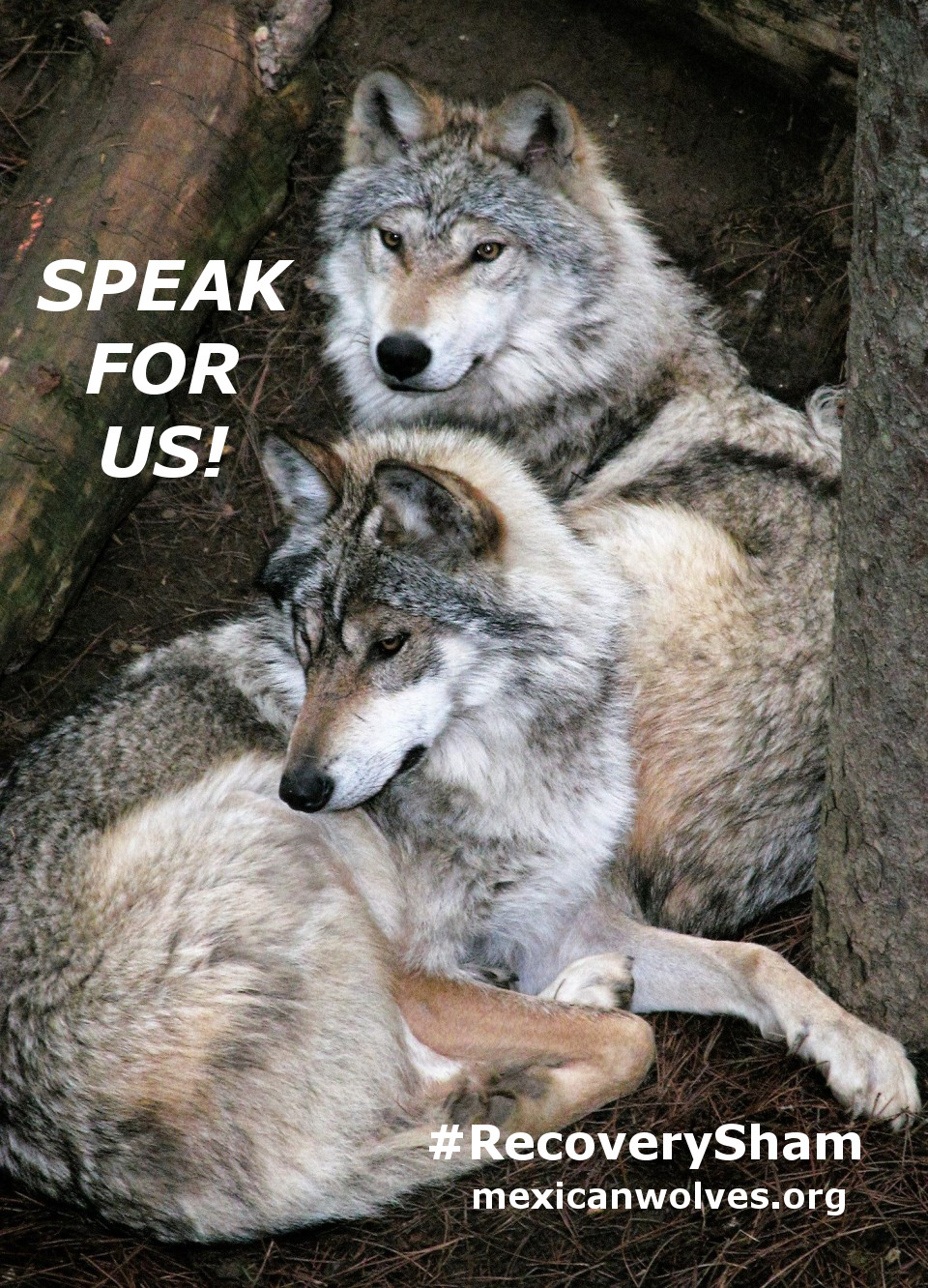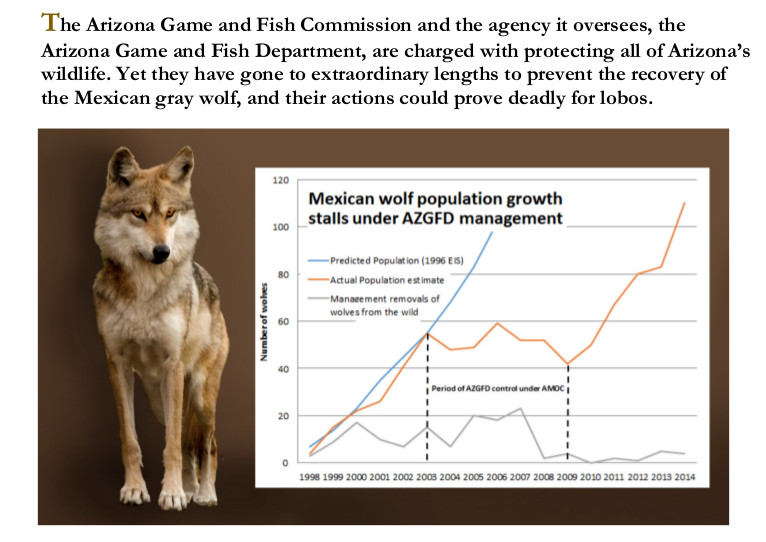19
Jul
In the News: Wolf plan gets skeptical greeting at Flagstaff meeting

Federal wildlife managers in charge of a new draft recovery plan for the endangered Mexican gray wolf received a barrage of questions during a public meeting Tuesday night that suggest the plan still has many skeptics.
Many people during the three hour event in Flagstaff asked the U.S. Fish and Wildlife Service to defend both its wolf population targets as well as provisions in the newly released plan that limit the wolves to an area south of Interstate-40 in Arizona, New Mexico and Mexico.
Alicyn Gitlin with the Sierra Club was one of those who questioned why the Fish and Wildlife Service didn’t consider areas near the Grand Canyon for potential future Mexican wolf habitat, noting it is a relatively conflict-free roadless area with prey availability and the necessary vegetation.
“How can you be so sure that the Grand Canyon was not part of the historic range of the Mexican wolf?” Gitlin said.
Others questioned the more than $7 million a year the recovery program is expected to cost and pushed for more local input when it comes to decisions on how to deal with wolves that have threatened livestock.
Now, the process seems “real one-sided,” said Tad Dent, who used to work for Babbitt Ranches. Before the meeting, Dent said he would like the Fish and Wildlife Service to “leave it like it is” when it comes to the wolves and not to turn any more loose. He didn’t want any more taxpayer dollars going to a program he had no confidence would succeed.
About 30 wolf advocates also held a rally before the meeting where they held signs like “The road to recovery runs north of I-40” and “Recovery or bust.” As they chanted and mimicked wolf howls in unison, groups of cowboy hat-clad ranchers gathered in their own circles nearby, providing a striking visual cue of the still-divided debate about recovery of the Mexican wolves in the Southwest.
Among the topics discussed at the meeting:
- The plan’s population recovery goal of 320 wolves in Arizona and New Mexico and 170 wolves in Mexico, which is far less than the 750 wolves a 2012 panel of wolf experts said would be needed for recovery. Sherry Barrett, the Mexican wolf recovery coordinator with the Fish and Wildlife Service, said the different numbers represent “differences in visions on how recovery could occur,” as well as new data plugged into population models. The 320 target also reflects the highest number the agency determined would be socially tolerable before the wolves would start affecting native ungulates like deer and elk as well as livestock, Barrett said.
- The plan’s focus on wolf recovery in only two areas in Arizona and New Mexico south of Interstate 40 as well as in Mexico. That also goes against the recommendations of the previous scientific panel, now put on hold indefinitely, which called for two more wolf populations to be established in the Grand Canyon region in northern Arizona and southern Utah and the Southern Rockies region in northern New Mexico and southern Colorado. Those areas are some of the “last best places for wolves,” said Craig Miller, with Defenders of Wildlife in an interview before the meeting. Barrett said the team decided to limit its analysis to an area south of I-40 because that is where science agrees wolves historically lived, while evidence of gets murkier about historic Mexican wolf habitation in other areas to the north.
- The fact that climate change could push wolf habitat northward. But John Oakleaf, the Mexican wolf field projects coordinator, said models show climate change won’t have major impacts on ungulate populations that are wolves’ main food source.
- The impact of construction of a border wall along the U.S.-Mexico Border. Tracy Melbihess, with the U.S. Fish and Wildlife Service, said that the plan doesn’t expect much movement between the Mexico and U.S. wolf populations. With human aided translocations between the populations and releases of captive wolves, “we could still achieve recovery,” Melbihess said.
- The ability for residents to legally shoot Mexican wolves if they feel the predators are threatening their life or someone else’s. A resident is also allowed to shoot a wolf on non-federal land if the animal is attacking a non-feral dog, Barrett said.
- Provisions in the plan that leave the responsibility for timing, location and circumstances of wolf releases up to the states of Arizona and New Mexico without any sort of way to enforce that the states stick to the wolf releases necessary for recovery. Those states have historically been against releases of wolves from captivity as evidenced by the Arizona Game and Fish commission’s 2015 vote to oppose all new releases of adult wolves and the state of New Mexico’s lawsuit against the U.S. Fish and Wildlife Service to halt wolf releases in that state.

(Read our report of state obstruction to wolf recovery HERE.)
“How can you be certain they will do everything they can to help recovery of the wolf?” asked Regan Downey with the Wolf Conservation Center in New York.
Barrett didn’t offer any guarantees or any potential enforcement mechanisms for ensuring state compliance with wolf releases, but only said that she has confidence the states will assist the federal wolf managers in getting the releases done.
“I’m an optimist,” she said.
Other wolf supporters expressed a similar distrust with state agencies.
“No (I don’t trust the AZGFD) they have a proven record not being a caretaker to the wolves or using scientific methods to run the program” Edwina Vogan.
Several spoke to the importance of Mexican wolves in the larger ecosystem.
“Any predator will help keep nature in line, there has been research done at Yellowstone that shows predators help bring a balance,” said Donna Cassano. “Also extinction is forever.”
OTHER GROUPS WEIGH IN
Other organizations on both sides of the wolf issue weren’t happy with the plan either.
“It’s pretty bad actually,” said Emily Renn, executive director of Grand Canyon Wolf Recovery Project said about the plan. “At this point I think conservation groups have been pushing for new recovery plan for the last 15 years and this is like the worst possible plan we could expect.”
Dave Parsons who was the U.S. Fish and Wildlife Service’s Mexican wolf recovery coordinator from 1990 to 1999, also criticized the fact that the plan was created without input from stakeholders outside of representatives with Arizona, New Mexico, Colorado and Utah wildlife agencies and a small group of scientists. The previous recovery process included a full range of stakeholders including the states, local tribes, sportsmens groups, outdoor recreation representatives and the conservation community, said Parsons, who is now with the nonprofit Project Coyote.
Patrick Bray, executive vice president with the Arizona Cattle Growers’ Association was equally opposed to the U.S. Fish and Wildlife Service’s plan.
He called the plan “beyond recovery” and said that with a current count of 113 wolves the federal government should be looking to end its involvement in the program and hand over wolf management efforts to the states.
“It’s time for the federal government to move on” Bray said. “This is a predator it doesn’t need extra help it knows how to hunt and survive. Let’s leave it alone.”
Bray was also frustrated by the Fish and Wildlife Service’s closed process.
His group had “absolutely no input,” Bray said.
“We would have preferred to be at the table,” he said.
This article was published in the Arizona Daily Sun.
~~~~~~~~~~~~~~~~~~~~~~~~~~~~~~~
Show your support for Mexican wolves with a Letter to the Editor today!
The letters to the editor page is one of the most widely read, influential parts of the newspaper. One letter from you can reach thousands of people and will also likely be read by decision-makers. Tips for writing your letter are below, but please write in your own words, from your own experience. Don’t try to include all the talking points in your letter.

Letter Writing Tips & Talking Points
“¢ The U.S. Fish and Wildlife Service is required, by law, to incorporate the best available science into its Mexican gray wolf recovery plan. Unfortunately, they have scrapped this duty in order to attain the best political deal they could find. They have chosen to make hostile state agencies happy rather than uphold their duty to consider the best available science. The previous recovery planning science team clearly identified what these wolves need, yet those findings are being ignored.
“¢ The U.S. Fish and Wildlife Service wants to hand the management of the Mexican gray wolf recovery program to the states who have done everything in their power to sabotage the species’ recovery. Arizona game and fish ran the program for six years previously, and in that time they managed to reduce the number of wolves in the wild. The serious genetic problems the wild population is in is a direct result of the mismanagement by Arizona. If this plan is not dramatically changed, it will very likely drive the lobo to extinction.
“¢ The Mexican gray wolf draft recovery plan includes reckless delisting criteria for the critically endangered wolf. The plan allows for delisting the wolf after twenty-two wolves released from captivity reach reproductive age. But just reaching reproductive age does not ensure their genes will be contributed to the wild population. We have seen that poaching is a major threat to individual wild wolves and if these wolves are killed before they breed, the species will still be removed from the endangered species list.
“¢ Mexican gray wolves will need connectivity between wild populations in order to recover. Connectivity would be easy were they allowed to establish in the two additional suitable habitats in the U.S., the Grand Canyon area and the Southern Rockies. Instead, the U.S. Fish and Wildlife Service is proposing to restrict the wolves to south of Interstate 40 and to establish a second population in Mexico. There is a barrier along large sections of the international border, talk of extending that barrier to an impenetrable wall, and the last wolf who crossed that border was removed from the wild.
“¢ The federal agency charged with recovery of the critically endangered Mexican gray wolf has decided to put the onus of recovery on Mexico, despite the fact that this could wipe the species out. Mexico does not have nearly as much public land for the wolf, they have very little enforcement to deal with poaching, and as species shift north in response to climate change Mexican habitat will become even less suitable for wolves.
Make sure you:
“¢ Thank the paper for publishing the article
“¢ Submit your letter as soon as possible. The chance of your letter being published declines after a day or two since the article was published
“¢ Do not repeat any negative messages from the article, such as “so and so said that wolves kill too many cows, but”¦” Remember that those reading your letter will not be looking at the article it responds to, so this is an opportunity to get out positive messages about wolf recovery rather than to argue with the original article
“¢ Keep your letter brief, under 250 words
“¢ Include something about who you are and why you care: E.g. “I am a mother, outdoors person, teacher, business owner, scientific, religious, etc.”
“¢ Provide your name, address, phone number, and address. The paper won’t publish these, but they want to know you are who you say you are.
Submit your letter to the editor of the Arizona Daily Sun
~~~~~~~~~~~~~~~~~~~~~~~~~~~~~~~~~~~~~~~~
DO EVEN MORE FOR LOBOS!
~~~~~~~~~~~~~~~~~~~~~~~~~~~~~~~~~~~~~~~~
Submit comments to the Fish and Wildlife Service before August 29
To review and comment on the draft revised recovery plan and related documents, visit www.regulations.gov and enter the docket number FWS—R2—ES—2017—0036 in the search bar.
~~~~~~~~~~~~~~~~~~~~~~~~~~~~~~~~~~~~~~
If you live in Arizona or New Mexico, please attend one of the four public meetings that the Fish and Wildlife Service is holding
– July 19, 6-9 p.m. Hon-Dah Resort, Casino Banquet Hall, 777 AZ—260, Pinetop, AZ
– July 20, 6-9 p.m. Ralph Edwards Auditorium, Civic Center, 400 West Fourth, Truth or Consequences, NM
– July 22, 2-5 p.m. Crowne Plaza Albuquerque, 1901 University Boulevard NE,
Albuquerque, NM
Thank you for taking action for the Lobos!



